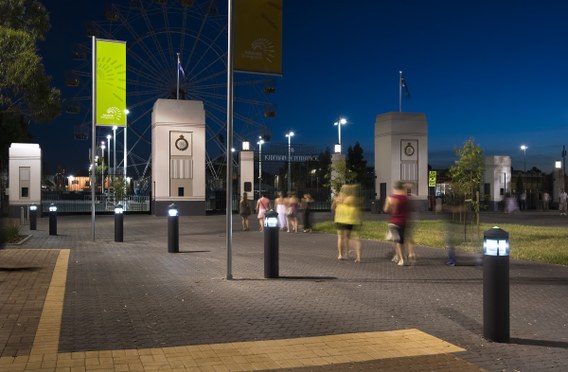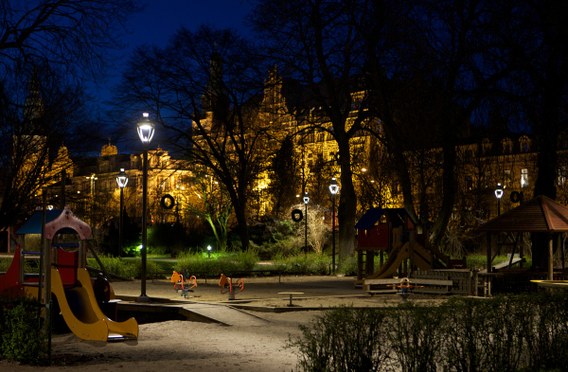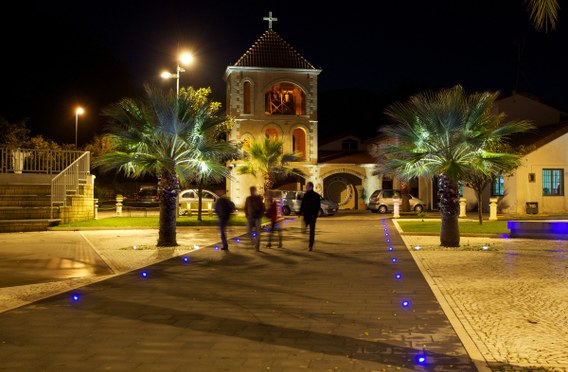Cityscape
Creating the right environment
The urban lit environment is more than a collection of roads; it is a vista of parks, pedestrian areas, building facades, shop windows, etc. To make cities safe and exciting places to be requires careful consideration of all of these to paint a coherent and pleasing panorama of light. This requires consideration of many issues such as brightness contrast, colour contrast in terms of warmer and cooler colour temperatures, drama from highlighting artefacts or creating special effect, etc. between adjacent areas at the local and districts level, which is between adjacent buildings or objects and also between spaces and districts.
It is increasingly common for local government to design urban plans for towns and cities which specifies lighting requirements and concepts to help in this process. However this will frequently have an extra unplanned layer of light caused by private initiatives and in business areas the presence of large glass facades with internal lighting that projects a presence into the area.
Careful consideration should be given to the mix of traffic types encountered in cities, motorised, cyclists, pedestrians, etc. with a wide age range from the elderly and less mobile to the young and less predictable pedestrians. The lighting requirements for urban roads are given in the document EN 13201 Road Lighting.
Best practice
The luminaires should be appropriate for the local climactic conditions. The urban landscape can create streets and pathways that act as wind-tunnels so fittings in these areas should ideally be shaped and mounted to minimise windage, which is the effect of wind producing a stress on the luminaire and all mounting equipment. All brackets, columns, etc. should be rated to withstand the maximum windage that will be encountered. In areas where a luminaire may encounter harsh treatment, either through deliberate vandalism or accidently, the luminaire should be capable of withstanding mechanical shock and where necessary have a vandal-resistant design.
Positioning of luminaires should provide maximum guidance as to the geometry of a space, be it a street or open space, and should give a coherent visual story to the users in the space. Façade lighting levels should be balanced to prevent the commercial need for prominence resulting in escalating levels between adjacent properties, but equally care should be taken to prevent areas with no light or deep shadowing. The use of well engineered product in a well thought out design will help minimise obtrusive light spilling onto neighbouring areas or upwards into the sky. This will not only reduce waste light (and therefore energy) but provide the dark conditions necessary for human and animal wellbeing, especially important in residential areas. Consideration should also be given to daytime appearance and the fixtures, brackets and columns should not intrude unpleasantly into the daytime scene.
At areas of change, for example potential obstacles such as kerbs from pathway to road, steps, areas of vegetation etc. lighting and shadows should be carefully controlled to aid users with low visual capacity to navigate through the space. Columns and lighting equipment should be positioned to aid in this process by not adding additional obstacles to the environment.
Taking control
The use of photocell switching to react to levels of daylight or timed on/off can ensure the correct light at the required time. Gradually reducing light levels in a controlled manner can allow an urban centre to slowly "go to sleep" in response to falling demand. This should still maintain a level of safety, for example reducing lighting in a central square whilst maintaining levels on a few key paths or reducing lighting to upper levels of building facades whilst maintaining illuminance at ground level. If the general ambient light level within a space can be reduced then lower light levels on key routes can have a comparable effect as raised levels in a high ambient light environment.
The use of luminaires with highly efficient electronic control gear and light sources, combined with good optical control optimised for urban spaces, will maximise the effectiveness of the lighting whilst minimising the required energy. Combining these with a communications module to allow centralised control and monitoring of light fixtures can open up many additional possibilities such as reacting to unexpected events and emergencies by increasing the lighting levels, adjusting dimming programs to provide light for planned public events, reducing maintenance issues by centrally monitoring lamp burning hours and checking the operation of lamps and components, etc.
In the near future presence detection will become more common, allowing lighting to activate from a dormant state (either totally off or dimmed) in the presence of traffic. Consideration of the speed of traffic, both motorised and pedestrian, will be necessary to provide the correct amount of lighting in front and behind the user to give safe and comfortable conditions.
Key products for this application are:
- Plurio
- Clan
- Avenue F



